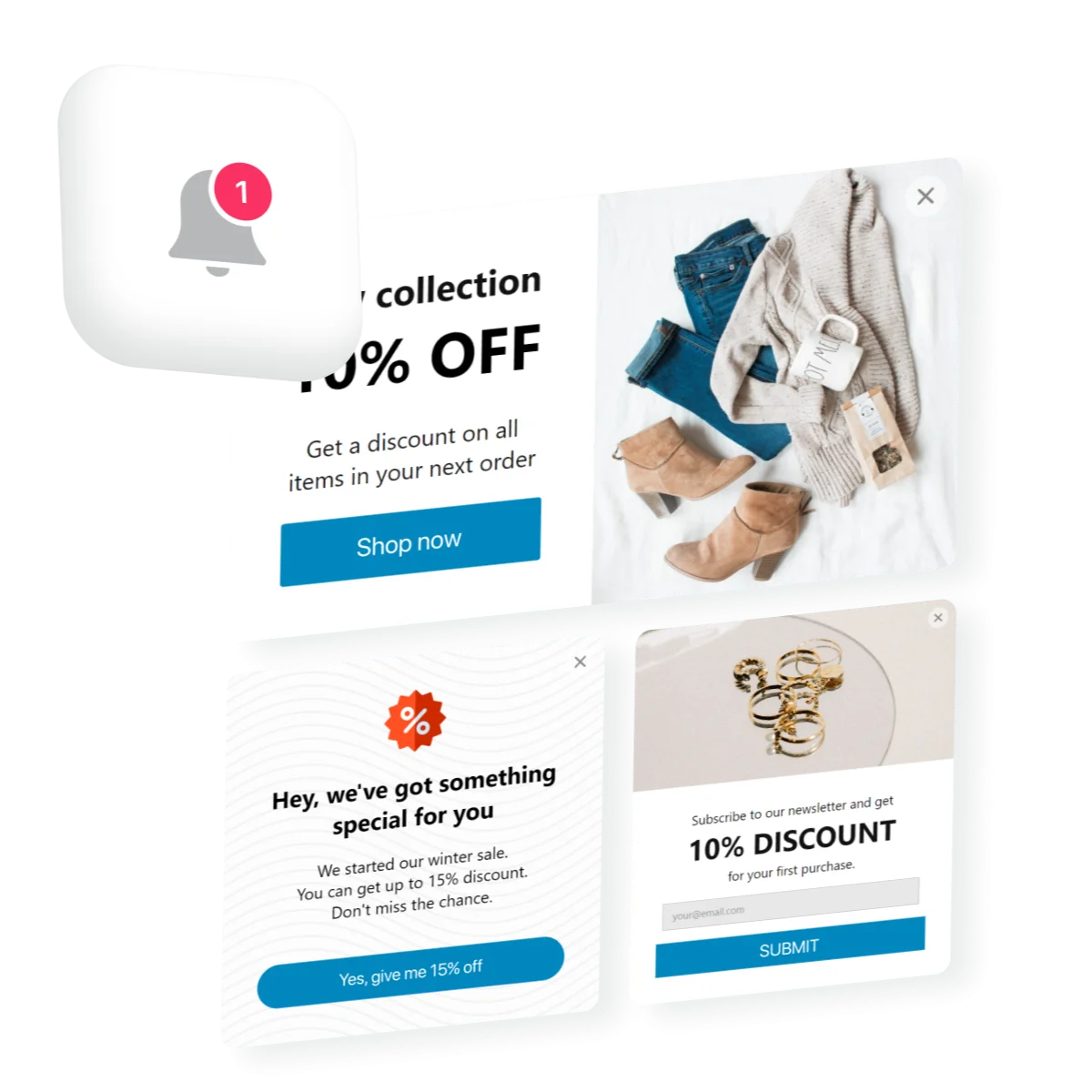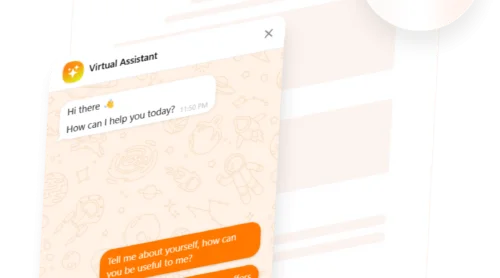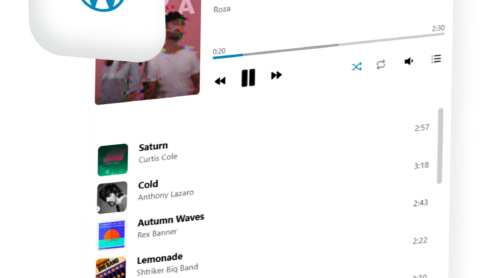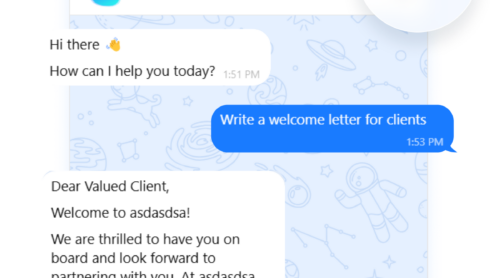What Are Web Push Notifications?
Web push notifications are short, clickable messages sent directly to users through their web browser, even when they are not actively browsing your website. Acting as a direct communication channel, these web notifications deliver timely updates, exclusive offers, reminders, or personalized messages straight to your users’ screens.
Unlike emails or SMS, web push notifications don’t require personal details like an email address or phone number. This makes them a privacy-friendly, hassle-free way to connect with your audience. They’re quick, clickable, and incredibly effective at grabbing attention.
What Makes Up a Web Push Notification?
A well-crafted web push notification typically consists of the following key components:
- Title
The headline is the first thing your audience sees, so make it irresistible to immediately grab attention. It is often concise and highlights the core message, such as “Exclusive Offer!” or “Reminder: Your Cart Awaits!” - Message body
This is where you add the details. It provides the user with context or additional information about the notification. Aim to be short and intriguing. For example: “Your favorite items are back in stock – hurry before they’re gone!” - Eye-catching icon
A small image or your brand logo adds a visual touch and represents the sender or the content of the notification. It’s a simple yet effective way to boost recognition and make your push notification for website stand out. - Call-to-action (CTA) button
Encourage action with clickable buttons like “Shop Now,” “View Details,” or “Learn More.” These drive users straight to where you want them to go. - A redirect URL
Every notification needs a destination. Whether it’s a sale page, blog post, or sign-up form, a good URL ensures users land exactly where they need to. - Perfect timing
Timing is everything! Whether it’s sending during a flash sale or a friendly reminder to check out, your notifications should appear when they’re most relevant.
By combining these elements with creativity and precision, you can turn simple notifications into powerful tools that drive traffic, increase conversions, and enhance customer retention.
How Do Web Push Notifications Work?
Web push notifications operate through a blend of browser technology and user permissions, making them an efficient and user-friendly communication tool. Here’s a step-by-step breakdown of how they work:
- User opt-in
Before you can send web notifications, users need to grant permission. When they visit your website, a prompt typically appears asking if they’d like to receive browser push notifications. This opt-in ensures compliance with privacy standards while giving users control.
Example: A pop-up might say, “Stay updated with our latest deals—Allow notifications?” Once the user clicks “Allow,” they’re added to your list, and the system can send push notifications to their browser. - Subscription registration
When a user opts in, their browser creates a unique identifier called a subscription token. This token doesn’t include personal information but allows your website to recognize the user and send notifications to their device.
The subscription is stored in the browser and connected to a push service – a server that routes notifications to the right devices. Each browser (like Chrome, Safari, or Firefox) has its own push service, ensuring compatibility across platforms. - Notification creation
The magic begins on your end. Using a web push service, plugins or widgets, you create a message tailored to your audience. This includes the notification title, message body, icon, CTA button, and URL.
Pro tip: Ensure your message is clear and actionable to maximize engagement. - Delivery via push service
Once your website notification is ready, it’s sent to a push service, which acts as the middleman between your website and the user’s browser. This service ensures your message is delivered to the correct user, even if they’re not actively browsing your site. - Browser displays the notification
Finally, the user’s browser receives the message and displays it as a pop-up notification on their device. These notifications are highly visible, appearing on desktops or mobile devices even when the browser is minimized.
This system enables businesses to reach users in real time without needing their email addresses or phone numbers. Whether it’s alerting them about a flash sale or reminding them of an abandoned cart, push notifications on your website provide a direct and efficient way to stay connected.
When paired with tools like Elfsight’s widgets, setting up and managing notifications becomes even easier. Plus, these widgets allow you to customize notifications to match your branding and goals effortlessly.
Benefits of Web Push Notifications
Website push notifications have become a game-changer in digital marketing, offering businesses a direct, efficient, and engaging way to communicate with their audience. Here are the key benefits that make them a must-have tool for your website:
| Benefit | Description |
|---|---|
| Instant Communication | Web push notifications are delivered in real-time, ensuring your message reaches users at the perfect moment. |
| Higher Engagement Rates | Compared to email or SMS, web push notifications have higher click-through rates due to their eye-catching design and concise messaging. |
| No Personal Information Needed | Users don’t need to provide email addresses or phone numbers, making the opt-in process simple and privacy-friendly. |
| Reach Users on All Devices | Web push notifications work across all devices including desktops, tablets, and mobile phones, as long as the user has enabled notifications in their browser. |
| Cost-Effective Marketing Tool | Unlike paid ads or SMS campaigns, web push notifications don’t incur additional costs once set up, making them a cost-effective solution for businesses of all sizes. |
| Re-Engage Users Effectively | Web push notifications can target users who visited your site but didn’t convert, reminding them to complete actions like purchases or check content. |
| Customization and Personalization | Elfsight’s tools like the Sales Notification and Popup widget allow deep customization and personalization of web push messages based on behavior, preferences, or location. |
| Boost Website Traffic & Conversions | Push notifications on your website can direct users to key pages with strong CTAs, driving traffic and encouraging conversions. |
Web push notifications offer unmatched versatility and effectiveness. With tools like Elfsight’s customizable widgets, you can seamlessly integrate them into your website and start enjoying these benefits today!
Types of Web Push Notifications
Web push notifications are versatile tools that can serve a wide range of purposes, from driving sales to enhancing user engagement. Here are some popular types and examples of web push notifications designed to cater to specific goals, making them highly effective when tailored to your business needs.
1. Welcome notifications
Welcome notifications are the first impression you make on new users or subscribers. These notifications set the tone for your relationship with them, offering a warm greeting and often an incentive to encourage immediate engagement. By making new visitors feel valued from the outset, welcome notifications help build trust and encourage users to interact with your brand.
Example:
“Welcome to [Your Brand]! Enjoy 15% off on your first purchase. Use code: WELCOME15.”
Best for:
- Onboarding new users
- Encouraging first-time purchases
- Building initial brand loyalty
2. Sales notifications
Sales notifications are all about creating a sense of urgency and driving sales. They alert users to limited-time offers, discounts, or flash sales. This type of notification can be further enhanced with tools like Elfsight’s Sales Notification widget, which shows real-time purchase activity, boosting trust and creating FOMO (Fear of Missing Out).
Example:
“Flash Sale! 30% off everything for the next 3 hours. Don’t miss out!”
Best for:
- Ecommerce websites
- Seasonal or holiday promotions
- Driving impulse purchases
3. Cart abandonment reminders
Cart abandonment is one of the most common challenges in ecommerce, and cart abandonment notifications are designed to bring users back to complete their purchases. These notifications remind users of their abandoned items and can include incentives like free shipping or discounts to drive them to finalize the transaction.
Example:
“You left something behind! Complete your order now and get free shipping.”
Best for:
- Ecommerce platforms
- Reducing cart abandonment rates
- Increasing conversions
4. Event announcements
Event announcement notifications are perfect for promoting webinars, product launches, or live streams. These notifications encourage users to engage with upcoming events and can create excitement by highlighting key details like start times or special offers.
Example:
“Join us live! Our new product reveal starts in 30 minutes. Don’t miss it!”
Best for:
- SaaS companies
- Content creators and influencers
- Product-based businesses
5. Content updates
Content update notifications alert users about new blog posts, videos, or other resources that match their interests. This type of notification helps keep your audience engaged by offering them relevant, fresh content. By keeping users informed about your latest offerings, you can build a loyal following and keep your website traffic consistent.
Example:
“New on our blog: 5 Tips to Boost Your Productivity. Check it out!”
Best for:
- Media websites
- Educational platforms
- Businesses leveraging content marketing
6. Popup notifications
Popups are attention-grabbing notifications that appear directly on your website. With Elfsight’s Popup widget, you can craft notifications for a wide variety of purposes, such as promoting offers, collecting emails, or reminding users about special events. Popup notifications are highly effective for lead generation and conversion optimization.
Example:
“Wait! Don’t leave yet. Subscribe now and get a free eBook!”
Best for:
- Lead generation
- Promoting offers before users leave
- Enhancing engagement with custom messages
Try the Elfsight’s Popup widget now in the intuitive editor and create stunning web push notifications tailored to your needs!
7. Re-engagement notifications
Re-engagement notifications are designed to win back users who have become inactive or lapsed. These notifications remind users of the value your site or app provides and encourage them to return. By offering discounts or personalized incentives, you can reignite interest and drive users back to your platform.
Example:
“It’s been a while! Come back and enjoy 20% off your next purchase.”
Best for:
- Retargeting inactive users
- Driving app or website visits
- Reviving lapsed customers
8. Feedback requests
Collecting feedback is crucial for improving customer experience, and feedback request notifications are a great way to gather valuable insights. These notifications ask users to rate their experience, provide reviews, or share opinions, which can help you refine your products and services.
Example:
“We’d love your feedback! Rate your experience with us in just 2 clicks.”
Best for:
- Ecommerce and service-based businesses
- Building social proof through reviews
- Enhancing customer experience
Web push notifications are a powerful tool, offering endless opportunities for customization and engagement, whether you’re looking to boost sales, re-engage users, or collect feedback.
How to Add Web Push Notifications to Website
Adding web push notifications to your website can be accomplished in several ways, depending on your technical expertise, platform, and goals. Here’s an overview of the most common methods:
Method 1: Push notification plugin or widget
A Push notification plugin or widget is an excellent solution for businesses that want an easy-to-implement and cost-effective method of adding push notifications to their website. Widgets like Elfsight’s Popup and Sales Notification offer a no-code solution, with all the essential features needed to drive engagement.
Follow these simple steps to add a push notifications plugin to your website:
- Select a template in the user-friendly editor.
- Customise it to align with your needs and website design.
- Copy the generated embed code.
- Paste it to your website.
It’s that easy!
- Easy setup. Installation is typically as simple as pasting a snippet of code into your website, without needing any coding skills.
- Customizable designs. Elfsight’s widgets offer highly customizable templates that allow you to match notifications with your website’s branding.
- Triggers & behavior rules. Notifications can be set to appear based on specific user actions, such as exiting the page, spending a certain amount of time on a page, or completing a purchase.
- Real-time notifications. Show real-time updates like recent purchases, special offers, or product availability to drive urgency and engagement.
- No coding required. This is an ideal solution for businesses that lack technical expertise. You don’t need a development team to set up or maintain the system.
- Quick integration. With plugins like Elfsight’s widgets, notifications can be live within minutes, making them a great option for businesses looking for a fast solution.
- Customizable & scalable. Elfsight’s widgets offer a high level of customization, so you can tailor the design and functionality to fit your needs.
- Affordable. Compared to other methods like Push API integration or using a service provider, widgets and plugins are often more cost-effective, especially for smaller businesses or startups.
- Limited functionality compared to APIs. While widgets like Elfsight’s Sales Notification and Popup are feature-rich, they may not offer as much flexibility or complexity as a custom-built push notification system.
- Dependence on third-party tools. Like services, you rely on the widget provider for support and feature updates, which may limit certain customizations in the long term.
Method 2: Push notification service
A web push notification service is an all-in-one solution provided by third-party platforms. These web push services typically offer advanced features like personalization, automation, and analytics. They are designed to streamline the process of creating, sending, and analyzing push notifications without requiring heavy technical input.
- Personalization. Customize notifications based on user behavior, such as location, browsing history, or purchase history.
- Custom opt-in prompts. Design engaging opt-in prompts that explain the benefits of subscribing to notifications.
- Automated campaigns. Automate push notifications for various triggers, such as cart abandonment, price drops, or back-in-stock alerts.
- Analytics and A/B testing. Measure the effectiveness of your notifications, analyze data, and improve campaigns over time.
- Ease of use. Minimal technical setup required. Most services offer user-friendly dashboards to create and manage notifications.
- Comprehensive features. Services usually come with built-in automation, personalization, segmentation, and performance tracking tools.
- Scalability. Ideal for businesses of all sizes, with the ability to scale as your customer base grows.
- Time-saving. Prebuilt templates, customizable designs, and automation can save a lot of time in managing campaigns.
- Subscription costs. Many services come with monthly or annual subscription fees that can grow with your usage, making them costly for smaller businesses.
- Limited customization. While there’s a lot of flexibility in terms of campaign management, there may be restrictions on how much you can customize the appearance and behavior of the notifications.
- Dependency on third-party providers. You rely on the service provider for uptime, support, and ongoing feature development, which can be a limitation if their service encounters issues.
Method 3: Push API integration
For businesses with in-house technical expertise or developers, Push API Integration provides the flexibility to build a custom solution. This approach involves using the JavaScript APIs offered by browsers like Google Chrome, Firefox, and Microsoft Edge to create a fully customized push notification system.
- Complete customization. Develop your own push notification solution tailored to your specific needs and user behavior.
- Direct control. Full access to the code and data, allowing for detailed management of notifications and integrations.
- Advanced functionality. If needed, this method allows the integration of complex features like multi-platform synchronization and deep linking.
- Total control. You have full control over the appearance, content, and behavior of notifications.
- Highly customizable. Design a system that works perfectly for your business model, whether it’s an app, service, or a complex user flow.
- No third-party dependencies. Avoid paying for subscriptions or being reliant on external providers.
- Requires development resources. You need a development team with expertise in web push technologies to integrate and maintain the system.
- Ongoing maintenance. Push notifications systems created with APIs require continuous maintenance to ensure they work across all devices and browsers.
- Higher initial cost. Depending on your in-house development resources, setting up an API-based system can be more time-consuming and expensive than using a pre-built service.
Why choose Elfsight’s widgets for push notifications?
Elfsight’s Popup and Sales Notification widgets are designed to make adding push notifications to your website simple, fast, and effective, without the need for coding skills or a hefty development budget. These widgets stand out due to their ease of use, customization options, and the ability to integrate seamlessly into your website. Let’s take a closer look:
Popup Widget
- Fully customizable designs that can match your brand’s aesthetics.
- Pre-designed templates for a range of goals: discounts, lead generation, event reminders, and more.
- Triggers for specific user behaviors like page exit or time spent on the page.
Sales Notification Widget
- Real-time notifications showing recent purchases or sign-ups, creating social proof.
- Customizable style, timing, and placement for the notifications.
- Easy integration with just a snippet of code.
- Simplicity. Set up notifications in minutes, no technical skills required.
- Flexibility. Highly customizable to meet your exact needs.
- Cost-Effectiveness. No need for a dedicated development team or expensive subscription plans.
Elfsight widgets are the perfect solution for businesses that want to implement push notifications quickly and efficiently while maintaining a polished and professional appearance.
Ready to transform your website? Try Elfsight’s intuitive editor and see how easy it is to enhance your website with high-performing notifications!
Best Practices for Web Push Notifications
To ensure your web push notifications deliver value and engage users effectively, follow these unified best practices.
- Build trust with clear opt-ins
The success of your web push notifications starts with a transparent opt-in process. Clear, user-friendly opt-ins help establish trust, reduce friction, and increase subscription rates. When users understand exactly what they are subscribing to, they are more likely to opt-in and engage with your notifications.
Tip: Offer a preview of the content they’ll receive, such as “Get real-time updates on exclusive deals!” Customize the opt-in message to match your brand.
Why it works: When users understand the benefits and frequency of notifications, they are more likely to subscribe willingly and engage with your content. - Segment your audience
Audience segmentation is crucial to delivering personalized and relevant notifications. By grouping users based on behaviors, demographics, or interests, you can send targeted messages that resonate with each user segment.
Tip: Create segments like new visitors, returning users, or cart abandoners to tailor notifications for each group.
Why it works: Personalized notifications resonate better, leading to higher engagement and conversion rates. - Send notifications at the right time
Timing plays a critical role in the effectiveness of web push notifications. Sending notifications at the right moment can increase the likelihood of users engaging with your message, as they are more likely to be receptive when it aligns with their current needs or interests.
Tip: Schedule notifications based on user activity patterns, such as sending a cart reminder 30 minutes after abandonment or promoting sales during peak browsing hours.
Why it works: Timely notifications catch users when they are already interested, boosting click-through and conversion rates. - Keep content concise and actionable
Web push notifications should be brief, direct, and easy to understand. A short message with a clear call-to-action (CTA) increases the likelihood of users taking the desired action, whether it’s completing a purchase, reading a blog post, or subscribing to a deal.
Tip: Use attention-grabbing headlines and include a clear CTA (e.g., “Shop Now” or “Learn More”). Pair the text with relevant visuals like your logo or product image.
Why it works: Users appreciate concise communication, and a strong CTA encourages immediate action. - Test and refine your strategy
Regular A/B testing allows you to identify which elements of your notifications are working and which aren’t. By testing different headlines, images, or CTAs, you can continuously improve your push notification strategy.
Tip: Experiment with different headlines, images, and CTAs, testing one variable at a time for actionable insights.
Why it works: Continuous optimization improves engagement and ensures your notifications align with user preferences. - Align notifications with user intent
Tailoring your notifications to match the user’s stage in their journey can significantly improve engagement. For example, the needs of a first-time visitor differ from those of a returning user or someone who has abandoned their cart.
Tip: For cart abandoners, use dynamic content like “Don’t miss out! Your cart is waiting.” For new visitors, offer welcome discounts or featured products.
Why it works: Contextual notifications make users feel understood, improving their overall experience and likelihood of engagement. - Monitor performance and adjust regularly
Consistent monitoring of your push notifications’ performance helps you identify trends, measure success, and adjust strategies for better outcomes. Setting specific KPIs (key performance indicators) ensures you’re focusing on the right metrics.
Tip: Set clear KPIs, such as increasing conversions or reducing cart abandonment, and use analytics to track your progress.
Why it works: Regular adjustments ensure your notifications remain relevant and effective, driving better results over time.
Aligning your approach with these strategies can help you create a more personalized, effective notification experience for your users, leading to increased conversions and greater customer loyalty.
FAQ
Which tools can send notifications to users of websites?
How to increase push notification opt-ins?
- Use an eye-catching opt-in prompt explaining the value users will get.
- Keep the message clear and concise.
- Offer incentives like discounts or exclusive content for subscribing.
What’s the difference between web push and mobile push notifications?
- Web Push Notifications are sent via web browsers and can reach users on both desktop and mobile devices as long as they use a supported browser.
- Mobile Push Notifications are app-specific and require users to have an app installed on their mobile device.
How can I segment users for push notifications?
- Behavioral data: Target users who have shown interest in specific products or pages.
- Demographics: Personalize messages based on location, age, or language.
- Engagement status: Send re-engagement notifications to inactive users or abandoned cart reminders to those who didn’t complete a purchase.
Conclusion
Now that you understand what web push notifications are, their benefits, and how to implement them effectively, it’s time to take action. Engaging your audience in real time, boost your website traffic, recover abandoned carts, and keep your customers informed – all with just a few clicks.
With Elfsight’s tools like the Popup widget and Sales Notification widget, you can make the process not only seamless but also enjoyable. Whether you’re a seasoned marketer or just starting out, Elfsight ensures an intuitive experience, powerful customization options, and instant results.
Don’t wait – start crafting your web push notification strategy today and watch as your engagement rates soar, your sales climb, and your customers keep coming back for more!







